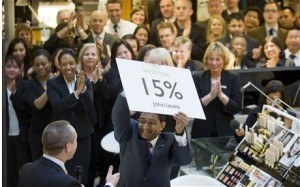John Lewis: A better way of doing business?

The UK’s leading retailer is owned not by outside shareholders but by its employees. The result? A company that maximises ‘happiness’ for its employees, is experiencing record levels of sales and has been voted the ‘UK’s favourite retailer’ for the fourth consecutive year.
Introduction
John Lewis, a UK department store chain, is one of the few companies that holds a special place in the hearts of British consumers. From its modest beginnings in 1864, when the very first day’s takings totalled 80p, John Lewis has grown into a middle-class mecca, with 45 John Lewis stores, over 300 Waitrose supermarkets and £10.9bn in annual revenues. The key differentiator of John Lewis’s operating model is the Partnership – every employee is a partner of the business and owns a stake. This co-ownership model is a unique way of aligning the business and operating models that many others in the UK market have been trying to learn from for decades.
Business Model
John Lewis aims to be the UK’s leading retailer by 2020, and its strategy is underpinned by three interdependent aims:
- Increase advantage of our Partners “happiness makes us all more motivated and effective”
- Realise market potential
- Grow efficiently
However John Lewis is in business to make ‘sufficient profit’ and not to maximise profit, unlike the majority of retailers. It is the Partners that John Lewis’s hopes to maximise for, not only in profits but in welfare too.
 The promise to customers is one of high quality merchandise at the best prices. The company’s moto ‘Never knowingly undersold’ speaks to this customer promise, with John Lewis guaranteeing customers a refund if they can find the same product for a lower price elsewhere.
The promise to customers is one of high quality merchandise at the best prices. The company’s moto ‘Never knowingly undersold’ speaks to this customer promise, with John Lewis guaranteeing customers a refund if they can find the same product for a lower price elsewhere.
Operating Model
The Partnership Model
All 93,800 of John Lewis’s employees are ‘Partners’ in the business, each with a stake in the business. Profits from John Lewis’s operations go directly to the staff in the form of an annual bonus, instead of heading to shareholders, “Partners share in the benefits and profits of a business that puts them first.” This annual bonus, usually around 10-15% of annual salaries, results in staff that are significantly better paid than their contemporaries at other UK department store and supermarket chains. Staff are also able to access other perks, such as use of the yachts, country mansions and other leisure facilities that John Lewis owns at well below market rates. John Lewis is also one of the few UK companies to still offer final salary pension schemes to its employees.
The partnership model is also central to how the company is governed. John Lewis has three governing authorities, the Partnership Council, the Partnership Board and the Chairman. The Partnership Council is a democratically elected body that represents the Partners, and their view, as a whole. The Council entrusts management of the company to the Board, which delegates’ management authority to the Chairman. However the Council has the ultimate power to dismiss the Chairman if he fails to fulfil his responsibilities, and in this way holds the Chairman and Board to account.
Customer Experience
Customers enter John Lewis stores knowing exactly what they will find – high quality, reliable merchandise at prices that can’t be beaten (or else the customer can ask for a refund). John Lewis has a traditional outlook on customer service, prioritising the in-store experience and using digital as an enabler and complementary channel, rather than the emphasis of the company. The company focuses on making the customer feel valued, and spends over £8m a year on ‘goodwill gestures’, e.g. accepting returns beyond their warranty, or providing replacement products if customers break their merchandise on the journey home. John Lewis’s target customer market see themselves as solid, contributing members of British society, and the company looks to reflect back their customer’s values in their own.
“Make your business a mirror of your customer. This is behaviour that marks out John Lewis to the greatest degree. John Lewis customers tend to believe of themselves that: they show integrity and fairness, they’re competent, they show consideration and politeness and they are rational. We reflect these”
Conclusion
Engaging employees in how the business is run, creating an entrepreneurial culture whereby every employee is empowered to give great customer service, rewarding employees with an equal percentage share of the company’s profits, and providing above-market employee benefits has resulted in employee satisfaction scores that are consistently outstanding. John Lewis has created a model in which employee incentives are closely aligned with the company’s customer promise, and in doing so has managed to create a thriving business that continues to grow in a demanding retail market place.
Sources
http://www.theguardian.com/business/2012/jan/16/john-lewis-model-lessons
http://www.rm2.co.uk/resources/blogs-news/employee-owned-business-models-john-lewis/
http://www.economist.com/node/21543161
http://www.johnlewispartnership.co.uk/about/our-founder.html
http://www.johnlewispartnership.co.uk/about/the-partnership/governing-authorities.html




This was a fascinating read as I’ve shopped at John Lewis many times but never knew about its operating model! I think they’re very unique how they made all employees Partners of the business and I’m sure it contributes significantly to the longevity of the company. Also interesting was the company’s strive to be entrepreneurial. I’ve never really associated the retailer as an innovative or entrepreneurial one so it was great to read how they really emphasized the customer experience by employing the partnership model.
Great article. The sufficient profit really caught my attention. One would think that you need to maximize all avenues of profits so that your competition does not slowly beat you out of the market. However I can see the other side, where in other to keep sufficient profits, the three governing bodies are alert to any threat and will act accordingly.
Nice post, Elena – I’ve highlighted a few comments and questions below:
-Based on Hyon Bin’s post above, it seems that customers aren’t made aware of John Lewis’ unique operating model. Do you think that the company could benefit by sharing this story with customers (e.g., so that customers know why there is a strong employee focus on customer service)?
-You mentioned that other companies in the UK have tried to learn from this. Have there been other companies that have successfully (or unsuccessfully) employed this model? What are the key lessons that other companies can take away regarding implementation?
-Does the company have any plans to expand beyond the UK? If so, what would this type of international expansion look like?